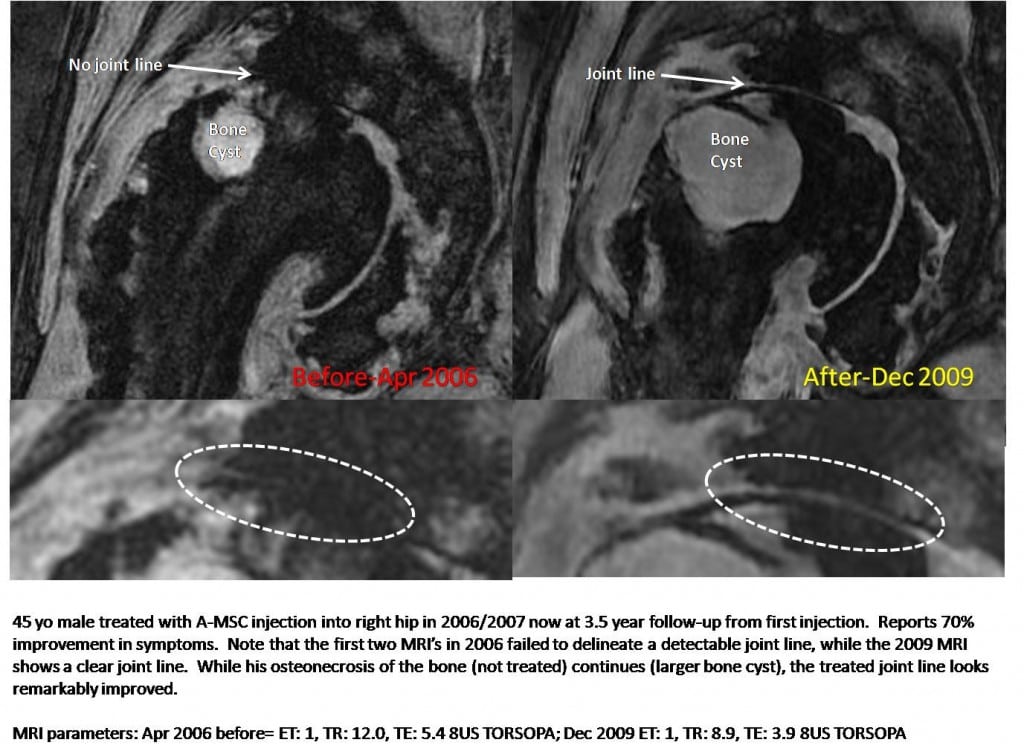Severe Hip Osteonecrosis and an Obliterated Joint Line
SL was one of our first study patients 3.5 years ago. He received multiple stem cell injections for his end stage, severe right hip arthritis. He had a big hole in the femur bone, likely due to prior osteonecrosis/AVN, a disease where the bone dies off. While we weren’t treating ON/AVN back then, we did inject cells into his hip joint (above the femur bone and not into the bone as our current ON/AVN treatment). We have followed him over the years and now he reports about 70% improvement in his hip pain about 3 years after stem cell therapy. Since his disease was so severe at the time he entered the study, his films were recently reviewed to see if we could determine if there had been any objective improvements in the appearance of the hip. His before and after films are below.

In both of his 2006 MRI’s, try as I might, I couldn’t find a viable joint space. This means that the two bones (ball and socket of the hip) are either fused together or close to that point. To get there, the joint has to be obliterated. However, in the 2009 MRI on the same scanner and very similar imaging parameters, there is a joint space that can be seen (the two enlarged pictures at the bottom of the above images-the joint space is encircled by the while dashes). Note the picture on the left shows very little visible horizontal light line (the joint space), but the picture on the right shows a clearly visible joint space. While the patient’s subchondral bone cyst (large light colored circlular structure) is bigger, that cyst had no “roof” over part of it in 2006, but does have a complete and thick bony roof in 2009. Generally, these cysts go one direction, i.e. they collapse and the round femur ball shape becomes a square peg in a round hole, necessitating a hip replacement. This is because at this stage the hip can become instensly painful. In this case, this didn’t happen, and the status of the joint line and contour of the “roof” of the cyst has remarkably improved.
A second follow-up on another very severe hip arthritis patient is CS, which was also just received today. She had post-polio syndrome with severe hip osteoarthritis. I was unsure how we were going to be able to help her hip due to the severity of the arthritis and the weakness of the surrunding muscles from the post-polio. While we don’t have the imaging from CS due to her not being part of a clinical study, we do have her comments and outcomes from her 18 month follow-up. I think it’s best to let her comments speak for themselves:
“Hi …- I completed the survey but I know it is skewed a little because of the Post Polio Syndrome. I think I am doing great! Little pain here and there but no big deal. I am in…and just lived thru 7 kids and grandkids for a week and did just fine….even successfully chased after 2 16 month old twins and not one escaped!
Hi to all and keep up the good work!”
SL’s imaging results are similar to a patient with severe hip arthritis that we published on in 2006. It’s also interesting to note that with our current grading system we would place both SL and CS in the poor stem cell treatment candidacy grade.
(Please note, these patients were treated with the Regenexx-C cultured stem cell procedure and not Regenexx-SD. While Regenexx-SD does rely on the same stem cell type that was used to treat these patients and other clinics have reported good results using similar procedures that don’t rely on stem cell culturing, Regenexx-SD clinical effectiveness has not yet been established.)

NOTE: This blog post provides general information to help the reader better understand regenerative medicine, musculoskeletal health, and related subjects. All content provided in this blog, website, or any linked materials, including text, graphics, images, patient profiles, outcomes, and information, are not intended and should not be considered or used as a substitute for medical advice, diagnosis, or treatment. Please always consult with a professional and certified healthcare provider to discuss if a treatment is right for you.
